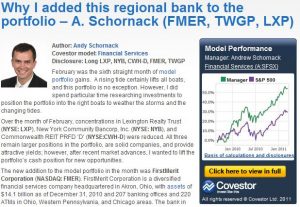 Welcome to the new Covestor blog! We’re doing a number of things here to augment our main site, but there are three elements I want to point out that I think constitute an evolutionary step forward for free market commentary: our managers’ commentary is always accompanied by a verified track record, we provide verified current holdings, and readers can choose to follow in an ongoing way not just a portfolio manager’s commentary, but also that manager’s actual trades.
Welcome to the new Covestor blog! We’re doing a number of things here to augment our main site, but there are three elements I want to point out that I think constitute an evolutionary step forward for free market commentary: our managers’ commentary is always accompanied by a verified track record, we provide verified current holdings, and readers can choose to follow in an ongoing way not just a portfolio manager’s commentary, but also that manager’s actual trades.
Take a step back and look at the current status of the financial blogosphere: the content’s outstanding, filtering tools are good and improving, but transparency still sucks.
Content in the financial blogosphere gets continually richer as more smart writers share insight from their particular fields of expertise and on a range of platforms – mainstream media outlets to personal blogs to Twitter. We’re no longer seeing the explosive growth in new blogs that characterized the scene a few years ago, but that’s probably a good thing in terms of overall quality.
On the filtering end, services like StockTwits and Seeking Alpha – where I was editor in chief from 2005-2010 – keep raising the overall signal to noise ratio with both the writers they permit access and the personalization/filtering tools they provide users. Then there are the invaluable daily link curators: Tadas at Abnormal Returns foremost among them, but also Barry Ritholtz, Josh Brown, Dan Primack, Tyler Cowen , Yves Smith and others. Business Insider’s careful selection of smart market blogs to republish in full contributes to filtering. And Felix Salmon seems to have something up his sleeve to provide algorithmic filtering a la Techmeme.
So outstanding writing is out there, and it increasingly makes its way to the readers who want it. The problem in the market blogging sector is the utter lack of transparency regarding the author. There’s no good reason for this to persist, given today’s web-based tools.
When you read an opinionated writeup about a stock, sector or the market overall, you naturally want to know two things: (1) what’s the author’s experience and track record (to determine credibility), and (2) what is the author currently holding (disclosure of vested interest)?
At Seeking Alpha, we relied on a voluntary disclosure from authors indicating if they held stocks named in their articles. We published this disclosure in footers, but we and our readers could never really be sure that the author held what they said they held, and we of course had no way to verify a track record (we weren’t about to audit brokerage reports). So if we received a bearish writeup on a Chinese stock, we’d publish it with the author’s disclosure on an honor rule basis, but what a reader really wants to know is if this author has been personally active in China investing, has a strong track record in picking Chinese stocks, and to know for sure if the author is currently short this particular stock. There can be value in a piece that lacks this transparency, but that value’s firmly in the ‘take it with a grain of salt’ area.
Compare that to a recent Andy Schornack post we published. Andy specializes in financial services stocks. As you read his assessment of a few bank stocks, you get not only a verified disclosure of his current positions (we have access to his Covestor-linked brokerage account), but also Andy’s verified track record. And if you’re impressed by Andy’s thinking and decisions, with one click you can begin the process of mirroring his trades in your own account, with stocks held in your own name. This is a leap forward in stock market blogging – for portfolio managers, readers and investors.
So please explore our blog (still working out some kinks) and sign up for our weekly email above. And let me know your thoughts about this new approach to market blogging in the comments below.


